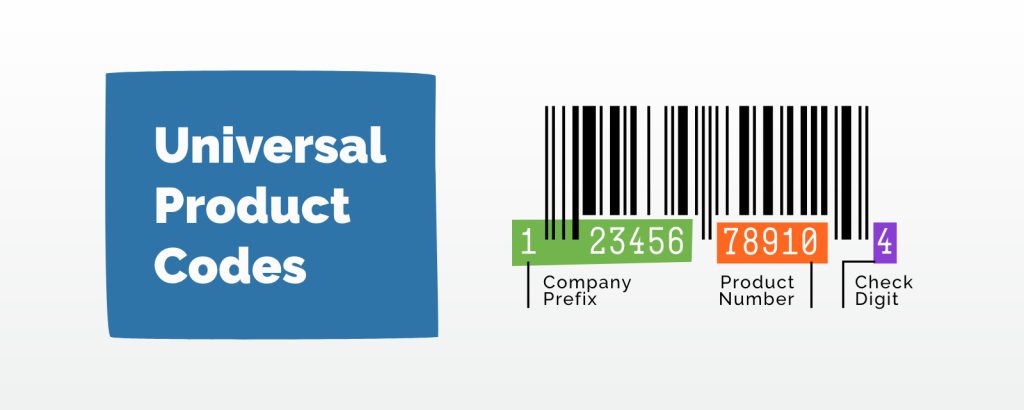Universal Product Codes (UPCs) are a standardized barcode symbology broadly used for tracking merchandise within the retail enterprise. They encompass a chain of black bars and white spaces that constitute a completely unique identification range assigned to a selected product or item. UPCs are ordinarily used for stock control, factor-of-sale (POS) transactions, and product monitoring for the duration of the supply chain.

History of UPC
- UPCs originated in response to retail challenges in the mid-20th century. Barcodes were invented in 1948, leading to collaboration between the NAFC and MIT in the 1960s to develop a standardized system.
- The first product with a UPC was scanned in 1974, and global standardization by GS1 followed in the 1980s. UPCs expanded beyond retail into various industries and evolved with digital innovations, including two-dimensional barcodes like QR codes, widely used in the 21st century.
Components of a UPC
A Universal Product Code (UPC) consists of several components that make up its structure, including:
- Number System: The first digit of a UPC represents the number system character, which identifies the type of product or industry.
- Manufacturer Code: The following five to six digits make up the manufacturer code, assigned to a specific company or brand by GS1. This code uniquely identifies the manufacturer or brand owner.
- Product Code: The subsequent five to four digits represent the product code, assigned by the manufacturer to a specific product or item within their range. It distinguishes one product from another.
- Check Digit: The last digit of the UPC is a check digit, which is calculated based on the previous digits. It helps verify the accuracy of the entire UPC when scanned.
These components collectively create a 12-digit UPC (or a shorter 8-digit or 13-digit version in some cases). When scanned, this barcode allows for the quick and accurate identification of a product at the point of sale and throughout the supply chain.
How UPCs Work
Universal Product Codes (UPCs) make shopping easier. Here’s how they work:
- Unique Numbers: Each product gets a special number from a group called GS1. It’s like a fingerprint for the product.
- Product ID: The company that makes the product adds more numbers to show what the product is. This makes a unique code for each item.
- Barcodes: These numbers become a barcode, which is like a secret code that machines can read. It’s made of black lines and white spaces.
- On the Product: The barcode is printed on the product’s package or label. It’s what cashiers scan at the store.
- At the Store: When you buy something, the cashier scans the barcode. The machine reads the code and knows what the product is and how much it costs.
- Inventory Control: The store’s computer keeps track of how many of each product they have. When products are sold, it updates the count.
- Supply Chain: Along the way, from the factory to the store, the barcode is scanned to keep track of where the product is.
- Fewer Mistakes: UPCs help reduce mistakes in stores and warehouses. They also help companies exchange information smoothly.
UPCs in Retail
- Universal Product Codes (UPCs) are like retail superheroes. They speed up the checkout line, so you spend less time waiting. They help stores keep track of what they have in stock, so you rarely hear, “Sorry, we’re out of that.” They ensure you’re charged the right price, so no surprises at the register.
- They give stores super-smart data to plan sales and offers that you love. They even help stop sneaky shoplifters. Plus, they make it a breeze for you to scan items, compare prices, and get extra product details on your phone. If there’s ever a product recall or issue, UPCs help stores quickly pull the affected items from the shelves to keep you safe.
- Behind the scenes, UPCs make sure that products flow smoothly from factories to stores, no matter where they come from. So, whether you’re buying local or international goods, UPCs keep the shopping world running smoothly for everyone.
Conclusion
In conclusion, Universal Product Codes (UPCs) have transformed the retail landscape, making shopping faster, more accurate, and more convenient for both retailers and consumers. These small but mighty barcodes streamline the checkout process, ensure price accuracy, and help retailers manage their inventory efficiently. Beyond the store, UPCs provide valuable data for retailers to make informed decisions and create promotions that benefit shoppers.
FAQs About UPC
A UPC typically contains a unique manufacturer code and a product code. It may also include a check digit for error detection.
Manufacturers or brand owners obtain a unique manufacturer code from GS1, which is used to create product-specific UPCs. These codes are converted into barcode format.
The primary purpose of a UPC is to streamline retail operations. It facilitates efficient checkout, inventory management, and data analytics. For consumers, it enables easy product identification and price comparison.
While most products in the retail industry have UPCs, not all products require them. Some exceptions include small businesses or niche products.
Related posts:
- AMC Full Form: Benefits, Components, Needs, Advantage
- ORS Full Form: Dehydration, Myths, Flavors, Varieties & Facts
- PCC Full Form: Importance, Types, Application Process
- PAN Full Form: Legal Provisions, Regulations,
- BRB Full Form: Productive, Routine, Distractions
- MCD Full From: Introduction, Responsibility, Challenges
- CT Scan Full Form: Scans, price, Advantages
- USA Full Form: History, Economics,Technology, culture




















